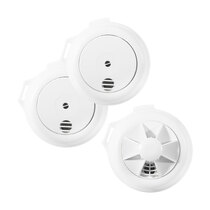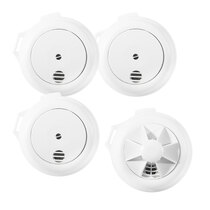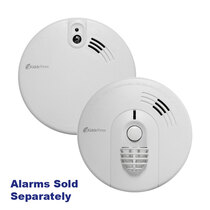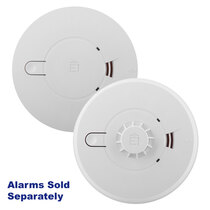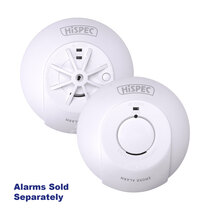-
Contact
Sales & Customer Service
0800 612 6537 support@safelincs.co.uk Live ChatDelivery Enquiries
0800 077 6149 - Resources
Fire & Safety Solutions
CALL OUR TEAM NOW 0800 612 6537
Lines open today 8am - 6pm
Free Delivery
on 100s of Products
Live Chat - Online
Instant help & Advice
Trade Discounts
and exclusive pricing
0% Credit Available
Open an account now
5 Star Customer Feedback
Mains Smoke Alarms
Permanent protection demands reliable power. Mains smoke alarms connect directly to your property's electrical supply, providing continuous fire detection backed by battery power during outages. Hardwired Reliability Mains powered smoke detectors eliminate concerns about dead batteries leaving you unprotected. These alarms draw power from your home's electrical circuit and maintain battery backup for complete peace of mind. Professional installation ensures proper positioning and electrical connection. An electrician connects the alarms to a lighting circuit or dedicated supply, guaranteeing consistent power and compliance with building regulations. The Kidde Slick series offers sleek, low-profile designs that blend seamlessly with modern interiors. Optical sensors provide excellent detection of smouldering fires, while sealed backup batteries last up to 10 years without replacement. Interlinked systems connect multiple alarms through wiring or radio signals. When one alarm activates, all connected units sound simultaneously, providing whole-house alerts that could save precious seconds during evacuation. Building Standards Compliance New builds and extensions require mains powered alarms meeting Grade D standards. These systems provide superior protection compared to battery-only units and satisfy building control requirements. Rental properties often mandate mains alarms for enhanced tenant safety. Landlords benefit from systems that tenants can't accidentally disable by removing batteries, ensuring continuous protection. Commercial properties utilise addressable systems that pinpoint the exact location of fire detection. These advanced networks integrate with building management systems for comprehensive safety monitoring. Advanced Features Modern mains alarms incorporate smart technology for improved performance. Multi-sensor units combine smoke and heat detection, reducing false alarms and maximising fire detection capabilities. Some models feature wireless modules that enable radio-interlink functionality without additional wiring. This flexibility allows system expansion without extensive electrical modifications. LED indicators provide visual confirmation of alarm status, power supply, and system integrity. These diagnostic features help you quickly identify any issues requiring attention. Our mains alarm selection includes options for every application. Professional guidance ensures you select appropriate systems for your specific requirements. For comprehensive fire protection advice, explore our detection system guides. Understanding the different technologies helps you make informed decisions about your property's safety. Contact our team for expert advice on mains smoke alarm specifications. We'll help you design a system that meets regulations and provide optimal protection for your property and occupants. Frequently Asked Questions (FAQs) What is the main advantage of mains smoke alarms over battery models? A mains smoke alarm is more reliable than battery models because it receives continuous power from the electrical supply, eliminating the risk of power failure due to dead batteries. Do mains powered smoke alarms still need batteries? Most mains smoke alarms incorporate backup batteries to maintain protection during power cuts, ensuring continuous fire detection even when the electrical supply fails. Can existing battery alarms be upgraded to mains power? Upgrading to mains smoke alarms requires an electrician to connect the units to your home's electrical circuit, which cannot be done as a simple replacement of battery units. How long do mains smoke alarms last? The lifespan of mains smoke alarms is typically 10 years for the detection sensors, though the electrical components may last longer with proper maintenance and testing.
Read more about mains smoke alarms...
Mains Powered 2 Smoke Alarms and 1 Heat Alarm Kit with Alkaline Back-up Battery - Kidde Firex KF Series
- Power: 230V mains powered with alkaline back-up battery
- Back-up Battery: 9V alkaline battery (included)
- Warranty: 6 year warranty
- Hardwire interlink with up to 24 devices
- Suitable for BS 5839-6: 2019 Grade D2 installations
- Also suitable for both the Welsh and Scottish 2022 legislation
Mains Powered Smoke Alarms & Heat Alarms with Alkaline Back-up Battery - Firehawk BB Series
These Firehawk mains-powered smoke and heat alarms with hardwire interlink and replaceable AAA alkaline back-up batteries are suitable for Grade D2 systems to warn all occupants of a fire.
- 230V mains power with alkaline battery backup
- 6 years manufacturer's warranty
- Hardwire interlink up to 15 Firehawk FHN smoke and heat alarms.
- Also suitable for the 2022 Scottish legislation
Mains Powered 2 Smoke Alarms and 1 Heat Alarm Kit with Alkaline Back-up Batteries - Firehawk
- Power: 230V mains powered with alkaline back-up battery
- Back-up Battery: 3 x AAA alkaline batteries (included)
- Warranty: 6 year manufacturer's warranty
- Hardwire interlink with up to 12 Firehawk FHN devices in total
- Suitable for BS 5839-6: 2019 Grade D2 installations
- Compliant with Scottish 2022, Welsh Landlord 2022, and Northern Ireland Landlord 2024 legislation
Mains Powered 3 Smoke Alarms and 1 Heat Alarm Kit with Alkaline Back-up Batteries - Firehawk
- Power: 230V mains powered with alkaline back-up battery
- Back-up Battery: 3 x AAA alkaline batteries (included)
- Warranty: 6 year manufacturer's warranty
- Hardwire interlink with up to 12 Firehawk FHN devices in total
- Suitable for BS 5839-6: 2019 Grade D2 installations
- Compliant with Scottish 2022, Welsh Landlord 2022, and Northern Ireland Landlord 2024 legislation
Mains Powered Smoke Alarms & Heat Alarms with Alkaline Back-up Battery - FireAngel W1-R Series
- Power: 230V mains powered with battery back-up
- Backup Battery: 9V alkaline battery (included)
- Warranty: 1 year warranty
- Available in Optical and Heat versions
- Interlinks with up to 12 units
- Kitemarked, CE marked and suitable for BS 5839-6: 2019 Grade D2
- Please note: alarms are sold individually
- Compliant with Scottish 2022, Welsh Landlord 2022, and Northern Ireland Landlord 2024 legislation
Mains Powered Smoke Alarms & Heat Alarms with Alkaline Back-up Battery - Kidde Firex KF Series
- 230V mains powered with alkaline back-up battery
- Available in Optical and Heat versions
- Interlink with up to 24 units
- Suitable for BS 5839-6: 2019 Grade D2 installations
- Kitemarked and CE marked
- Please note: alarms are sold individually
- Also suitable for both the Welsh and Scottish 2022 legislation
Mains Powered 3 Smoke Alarms and 1 Heat Alarm Kit with Alkaline Back-up Battery - Kidde Firex KF Series
- Power: 230V mains powered with alkaline back-up battery
- Back-up Battery: 9V alkaline battery (included)
- Warranty: 6 year warranty
- Hardwire interlink with up to 24 devices
- Suitable for BS 5839-6: 2019 Grade D2 installations
- Also suitable for both the Welsh and Scottish 2022 legislation
Mains Powered Smoke Alarms & Heat Alarms with Alkaline Back-up Battery - Aico Ei140e Series
- 230V mains powered with alkaline back-up battery
- Available in Optical and Heat versions (Ei146e, Ei144e)
- Made in Ireland by Ei Electronics
- Interlinks with up to 12 units
- Kitemarked, CE marked and suitable for BS 5839-6: 2019 Grade D2 installations
- Please note: Alarms are sold individually
- Also suitable for both the Welsh and Scottish 2022 legislation
Mains Powered Smoke Alarms & Heat Alarms with Self-Charging 10 Year Back-up Battery - Aico Ei3000 Series
- Available in Optical, Heat, Combined Optical & Heat, and Combined Heat & CO
- Mains powered alarms with sealed lithium back-up battery
- AudioLINK technology fitted as standard
- Interlinks with up to 12 compatible devices
- Compatible with Ei3000MRF SmartLINK Module for radio-interlinking
- Suitable for BS 5839-6: 2019 Grade D1 installations
- Also suitable for both the Welsh and Scottish 2022 legislation
Mains Powered Radio-Interlink Smoke & Heat Alarms with Lithium Back-Up Battery - Hispec RF10-PRO
These mains-powered alarms from Hispec feature RF10-PRO wireless interlink for whole-house coverage, with a sealed rechargeable lithium back-up battery and 5-year manufacturer's warranty.
- Optical Smoke and Heat sensor types available
- Wireless interlink up to 20 RF10-PRO devices
- Test & Hush feature, compatible with Hispec Remote Control
- Compliant with Scottish 2022, Welsh Landlord 2022, and Northern Ireland Landlord 2024 legislation
Mains Radio-Interlink Smoke Alarms & Heat Alarms with Self-Charging 10 Year Back-up Battery - Aico Ei3000RF Series
- Available in Optical, Heat and Combined Optical and Heat
- Mains powered alarms with tamper-proof lithium back-up batteries
- Suitable for BS 5839-6: 2019 Grade D1 installations
- Supplied with an Ei3000MRF SmartLINK Module for radio-interlinking
- Hybrid (wired or wireless) interlinking with up to 12 compatible devices
- Please note: alarms are sold individually
- Also suitable for both the Welsh and Scottish 2022 legislation
Mains Radio-Interlink Smoke Alarms & Heat Alarms with Alkaline Back-up Battery - Aico Ei140eRF Series
- 230V mains powered with alkaline back-up battery
- Available in Optical and Heat versions (Ei146eRF, Ei144eRF)
- Interlinks via radio frequency with up to 12 units
- Kitemarked, CE marked and suitable for BS 5839-6: 2019 Grade D2
- All alarms also act as repeaters
- Please note: alarms are sold individually
- Also suitable for both the Welsh and Scottish 2022 legislation
Mains Powered Radio-Interlink 2 Smoke Alarms and 1 Heat Alarm Kit with Alkaline Back-up Battery - Aico Ei140eRF Series
- Power: 230V mains powered with alkaline back-up battery
- Back-up Battery: 9V alkaline battery (included)
- Warranty: 5 year warranty
- Radio-interlink with up to 12 compatible devices
- Suitable for BS 5839-6: 2019 Grade D2 installations
- Compliant with Scottish 2022, Welsh Landlord 2022, and Northern Ireland Landlord 2024 legislation
Mains Powered Smoke Alarms & Heat Alarms with Self-Charging 10 Year Back-up Battery - Firehawk RB Series
With self-charging back-up batteries, these mains-powered smoke and heat alarms from Firehawk won't need new batteries for their full 10 year lifespan. Ideal for Grade D1 and Scottish installations.
- 230V mains power with self-charging lithium battery backup
- 10 years manufacturer's warranty
- Hardwire interlink up to 15 Firehawk smoke and heat alarms.
- Also suitable for the 2022 Scottish legislation
Mains Powered Smoke Alarms & Heat Alarms with Self-Charging 10 Year Back-up Battery - Kidde Firex KF-R Series
- 230V mains powered with self-charging lithium back-up battery
- Available in Optical and Heat versions
- Interlinks with up to 24 units
- Suitable for BS 5839-6: 2013 Grade D1installations
- Kitemarked and CE marked
- Also suitable for both the Welsh and Scottish 2022 legislation
Mains Powered 2 Smoke Alarms and 1 Heat Alarm Kit with Self-Charging 10 Year Back-up Battery - Kidde Firex KF-R Series
- Power: 230V mains powered with self-charging lithium back-up battery
- Back-up Battery: Self-charging 10 year back-up battery
- Warranty: 6 year warranty
- Hardwire interlink up to 24 compatible devices
- Suitable for BS 5839-6: 2019 Grade D1 installations
- Compliant with Scottish 2022, Welsh Landlord 2022, and Northern Ireland Landlord 2024 legislation
Mains Powered 3 Smoke Alarms and 1 Heat Alarm Kit with Self-Charging 10 Year Back-up Battery - Kidde Firex KF-R Series
- Power: 230V mains powered with self-charging lithium back-up battery
- Back-up Battery: Self-charging 10 year back-up battery
- Warranty: 6 year warranty
- Hardwire interlink up to 24 compatible devices
- Suitable for BS 5839-6: 2019 Grade D1 installations
- Compliant with Scottish 2022, Welsh Landlord 2022, and Northern Ireland Landlord 2024 legislation
Mains Radio-Interlink Smoke Alarms & Heat Alarms with Sealed Longlife Back-up Battery - FireAngel Pro Connected Series
- Power: 230V mains powered with sealed longlife back-up battery
- Available in Optical and Heat versions (FP1640W2-R and FP1740W2-R)
- Interlinks via radio frequency with up to 50 units
- Kitemarked, CE marked and suitable for BS 5839-6: 2019 Grade D1 installations
- Compatible with the FireAngel Pro Connected Gateway
- Please note: alarms are sold individually
- Also suitable for the 2022 Scottish legislation
Mains Powered Radio-Interlink 3 Smoke Alarms and 1 Heat Alarm Kit with Alkaline Back-up Battery - Aico Ei140eRF Series
- Power: 230V mains powered with alkaline back-up battery
- Back-up Battery: 9V alkaline battery (included)
- Warranty: 5 year warranty
- Radio-interlink with up to 12 compatible devices
- Suitable for BS 5839-6: 2019 Grade D2 installations
- Compliant with Scottish 2022, Welsh Landlord 2022, and Northern Ireland Landlord 2024 legislation
Mains Powered 3 Smoke Alarms and 1 Heat Alarm Kit with Alkaline Back-up Battery - Aico Ei140e Series
- Power: 230V mains powered with alkaline back-up battery
- Warranty: 5 year warranty
- 3 x optical smoke alarms and 1 x heat alarm included in the kit
- Central test and hush buttons
- Hardwire interlink with up to 12 devices
- Suitable for BS 5839-6: 2019 Grade D2 installations
- Compliant with Scottish 2022, Welsh Landlord 2022, and Northern Ireland Landlord 2024 legislation
Page 1 (20 of 22 Products)
Mains Smoke Alarms
Back-Up Batteries
Mains Smoke Alarms
Mains smoke alarms or mains powered smoke alarms are powered by the 230V from the mains wiring of the building. While replacement units and batteries can be easily changed, all wiring work should be completed by a competent person, such as an electrician, to ensure that it is safe and has been installed correctly. Mains smoke alarms can be wired into a special alarm wiring loop, which comes directly from the fuse box, or they can be fed from the nearest light fitting.
Retrofitting mains powered smoke alarms in older buildings, means that supply from a light fitting is often recommended and cheaper. However, care must be taken to ensure that the supply is wired correctly, and that the smoke alarm is not supplied by a ‘switched’ electric cable. Being wired to a ‘switched’ cable means that when in the ‘off’ position, the alarm may not function as it should and be only functional on its back-up battery. This is particularly problematic for sealed (Grade D1) smoke and heat alarms, as the battery cannot be changed, so the whole unit will need to be replaced if the battery is over-used.
Mains smoke alarms with any form of interlink (either hard-wired or using radio-interlink) fulfil BS5839-6 Grade D, which is required for extensions, new domestic buildings, let homes, HMOs, and many more applications.
Back-Up Batteries
All of our mains powered smoke detectors and heat alarms have back-up batteries, and therefore meet the Grade D requirements. Back-up batteries offer additional protection, by ensuring that the smoke and heat alarms still have a power supply, even if the mains power fails. Alarms with back-up batteries are either tamper proof devices for which the batteries last the lifetime of the alarm, or have and accessible battery compartment for the user to replace the alarms batteries within the alarm’s lifetime.
Replaceable back-up batteries (Grade D2):
These back-up batteries are often non-rechargeable, and specified as alkaline by the manufacturer. Usually, these require replacement every year or two, depending on how often they are used.
Non-replaceable back-up batteries (Grade D1):
These back-up batteries are a sealed-in rechargeable lithium cell, also known as a tamper-proof battery, which is designed to last the lifespan of the alarm. This type of back-up batteries are designed to trickle charge while there are connected to mains power and to provide full power, if the mains were to fail. These alarms are often found most useful in rented properties, in order to avoid tampering, deactivation, and the requirement for battery changes falling on the tenant.
Whether purchasing alarms fulfilling to Grade D1 or D2, the lifespan of any smoke or heat detector will usually be up to 10 years; the whole alarm must be replaced at this point. This is due to the sensor becoming less reliable, and more likely to falsely alarm.






















